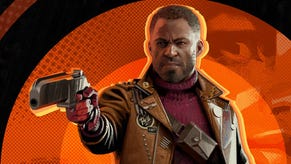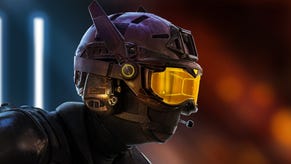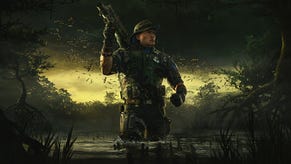Rainbow Six Siege review
Six pack.
Making plans is fun, but seeing them unfurl at your feet can be even more thrilling. We're two rounds apiece and heading into the tie-breaker in Rainbow Six Siege's banner multiplayer mode, and every move of our five-man squad has been sketched out meticulously. There are two team-mates on the roof and another two moving up the stairs, each pair slowly infringing upon the dusty confines of a cult's countryside complex. My task, quite simply, is to put the fear into our enemy, rattling my sabre and banging bullets through the windows of the little fort they've built for themselves, making them squirm as they swarm around the hostage being guarded in the middle of the room.
And that's when things start to go awry.
The pair on the roof are having too much fun rappelling down the side of the building on rope, and a small argument breaks out as they try to figure out who's going through the window first. Too late: two quick headshots later and it's three versus five. Meanwhile, on the perimeter, the other team places a breach and prepares a flashbang that comes bouncing off the freshly exposed door-frame and rolls slowly to their feet. One pop of searing white light later they're both blinded: another couple of pops of gunfire and they're both bleeding out on the floor. One versus five. It's okay. I've got this.
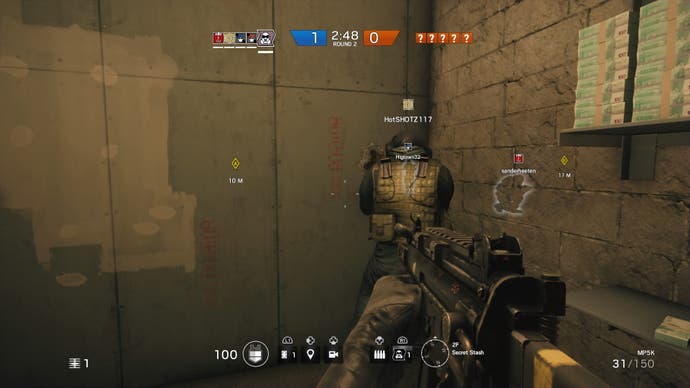
Such moments can make heroes of us all. Padding the corridors with the four other players offering advice as they watch via remote cameras placed around the map, the odds are slowly whittled back in our favour and the three-minute round stretches out into what feels like hours. A lucky shot through a flimsy wooden wall; a fumbled melee encounter that improbably goes my way - with 20 seconds on the clock it's one versus one, and the winning kill is a grenade toss away. Out comes the pin, in arcs the grenade that then rolls straight past the enemy, slowly coming to a stop by the bound feet of the hostage who I'm fairly sure fixes me with one final, familiar look: a mix of fury and disappointment, the same my partner fixes me with when I've accidentally used her toothbrush again. The hostage is dead. We've killed the prize.
I've not won too many matches in Rainbow Six Siege, but I've had an amazing time losing a load of them. Ubisoft Montreal's multiplayer-focused reboot of a series that's lain dormant for seven years takes plenty of inspiration from all that's happened since 2008's Rainbow Six Vegas sequel - there are traces of Call of Duty in its twitchy shooting, a little League of Legends in its roster of distinguishable characters and a fair amount of Counter-Strike in its breathless pace. What's most impressive, though, is how Ubisoft Montreal has managed to take the loop of the originals - considered preparation, followed by execution enabled by a suite of exotic toys, in short - and distil it into a punchy multiplayer shooter.
When it works - with a team of four friends co-ordinating attacks, or whimpering instructions when you're holed up in defence and can hear the foot-steps of a well-tuned squad slowly encroaching - it can be exquisite, a perfect mix of tension and comedy, of horror and high jinks. At its core, Rainbow Six Siege is a game of two halves, with teams taking it in turns playing in defence and attack. As defenders, you're given a window of preparation - 30 seconds with which to board up the windows, to barricade the walls and to lay down whatever manner of traps you've come equipped with. As attackers, that 30 seconds is used whizzing a team of remote controlled cars around, a recon race as you search for the objective and the enemy.
The 10 multiplayer maps that feature at launch - with four more promised, gratis, over the next 12 months - do a good job of playing to both sides, supplying defenders with enough points to funnel attackers through, and attackers enough entry points to make the opposition sit and sweat as they await the inevitable conflict. As is ever the way in Rainbow Six, they're earthy, pedestrian places carrying a surreal sense of the domestic - a deserted plane on a Heathrow runway, a training camp in Hereford or a snowed-in department store in Moscow - and they all share a certain B&Q vibe, with balsa wood panels to be splintered and breeze-block walls to blast through with breaching bombs. The destructibility that's at the heart of Rainbow Six Siege does a good job of refreshing each space as they come crumbling down: this is a game whose tactics run deep enough to surprise you after hours of play, and where even your best-laid plans can be punched through with a well-placed cake of C4.
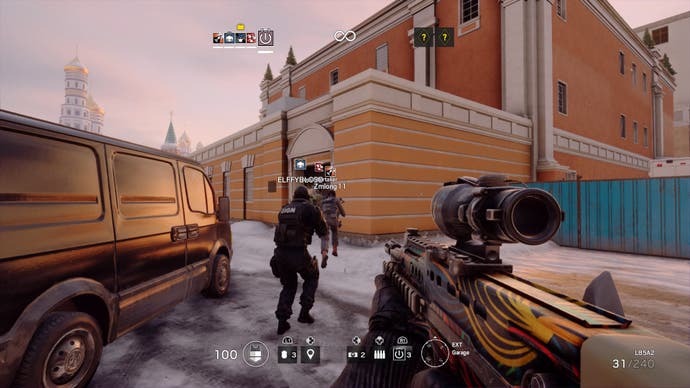
The 20 operators, unlockable through Rainbow Six Siege's in-game currency, also offer some tactical breadth, and understanding how to build a balanced squad soon becomes part of the process. They're split between attackers and defenders, each with their own bespoke gadget - a gun that can revive downed allies from afar, or an explosive that can breach any surface - with load-outs locked into each character. It's an effective simplification of the shooter staple, placing an emphasis on characters rather than weapons. All of which speaks to the MOBA-ish tendencies that belie Rainbow Six Siege's ambitions towards eSports.
Matches in Rainbow Six Siege are readable, pleasingly short and typically tense, so there's every chance it could flourish in that arena. For players without professional aspirations, however, some of the compromises made throughout Rainbow Six Siege can be painful. The lack of consideration for the solo player goes beyond the omission of a campaign (there is a suite of 'Situations', effectively a tutorial that can be seen off in an hour) and filters throughout into a game that can feel outwardly hostile towards anyone without a decent squad by their side.
In Terrorist Hunt, a PvE mode that has a squad working through objectives in which the enemy is hordes of AI, it's less of a problem. There's the same tension and drama that defines the core multiplayer mode, even if it's been slightly diluted - the maps aren't as fine a fit here as they are in multiplayer, while the enemy types can feel flat and uninspired. They're strangely lifeless thugs you're up against, limp hoodies sitting over their faceless white masks, and the introduction of bombers who rush players before detonating themselves feels clumsy and cheap.
Playing Siege online without a fully functioning squad can be an exercise in torture, too. On PC there's a more talkative, friendly crowd, but on console there's too often an awkward silence that leads to conflicting tactics and frustrating teamkills. Playing with friends or lucking into a more co-operative group is one answer, but it's a shame to not see more tools in place to encourage and facilitate communication between strangers.
Elsewhere, there's the awkward creep of micro-transactions in an all-too-prominent storefront on Rainbow Six Siege's title page. They're relatively tasteful in implementation, limited to cosmetic items such as weapon skins, though it's still possible to buy an XP boost to help you unlock each character at a faster rate. Do they impose themselves on the player? Not really, and Rainbow Six Siege is generous enough in what it doles out that it's possible to unlock characters and weapon augments quickly. Should they be in a full-priced game? That's more questionable.
As is the wisdom in releasing a full-priced game that's effectively a single multiplayer mode offered in a slim variety of flavours. Rainbow Six Siege is happy to look to the wider world of eSports, yet unlike its inspiration it neglects to lower the price of entry, which is an odd decision: Ubisoft seems torn between a typical big-budget release and a more focussed multiplayer shooter, and the rift often shows.
But what a multiplayer mode it is. If you're able to pull together a squad of friends, and able to make the plans necessary to see this at its best, there's nothing quite like it. Measured, tactical and frequently surprising, Rainbow Six Siege is one of the best multiplayer experiences of the year - but it comes at a cost.



